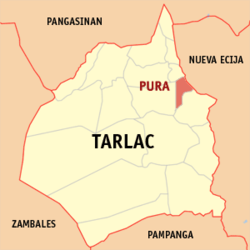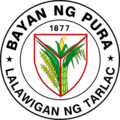Geography
Pura is located at the northeastern part of Tarlac, surrounded by the municipalities of Ramos to the north, Victoria to the south, Gerona to the west, and Guimba in Nueva Ecija to the east. It is 20 kilometres (12 mi) from the provincial capital Tarlac City, 61 kilometres (38 mi) from Clark Special Economic Zone (CSEZ) in Angeles City, and 144 kilometres (89 mi) north of Manila.
Pura has a total land area 3,142 hectares (31.42 km2; 12.13 sq mi) which represents 1.02% of the entire provincial area. It comprises 16 barangays of which barangays Poblacion 1, 2, and 3 are considered urban area and the rest are considered rural. The land area per barangay is shown in the table below.
It is one of the exits of the Tarlac–Pangasinan–La Union Expressway (TPLEX).
Topography
Most of the Municipality of Pura is on a plain slope-less area. The soil series of Pura are light brownish gray to heavy black granular surface soil. When dry, they are hard and compact and break into big clogs. The subsoil is brownish to nearby black columns to coarse granular clay loam. The municipality of Pura has two (2) distinct soil types: Luisita fine sand loam and Pura clay loam.
Climate
| Climate data for Pura, Tarlac |
|---|
| Month | Jan | Feb | Mar | Apr | May | Jun | Jul | Aug | Sep | Oct | Nov | Dec | Year |
|---|
| Mean daily maximum °C (°F) | 30
(86) | 31
(88) | 33
(91) | 35
(95) | 33
(91) | 31
(88) | 30
(86) | 29
(84) | 29
(84) | 30
(86) | 31
(88) | 30
(86) | 31
(88) |
|---|
| Mean daily minimum °C (°F) | 19
(66) | 19
(66) | 20
(68) | 22
(72) | 24
(75) | 24
(75) | 24
(75) | 24
(75) | 23
(73) | 22
(72) | 21
(70) | 20
(68) | 22
(71) |
|---|
| Average precipitation mm (inches) | 3
(0.1) | 2
(0.1) | 5
(0.2) | 10
(0.4) | 80
(3.1) | 107
(4.2) | 138
(5.4) | 147
(5.8) | 119
(4.7) | 70
(2.8) | 26
(1.0) | 8
(0.3) | 715
(28.1) |
|---|
| Average rainy days | 2.0 | 1.7 | 2.7 | 4.6 | 16.1 | 20.8 | 24.0 | 23.0 | 21.4 | 15.5 | 8.0 | 3.2 | 143 |
|---|
| Source: Meteoblue [6] |
Pura, just like any other town in the province of the Tarlac has two (2) pronounced seasons. The wet season that starts from May up to lasts up to September and dry from the month of October to April. This type of climate is typically hot, humid, and tropical and is generally affected by the neighboring topography and prevalent wind direction that varies within the year. Tropical monsoon is carried into the area from the southeast in the month of May to September thereby causing heavy rainfall in the area. Most of the rainfalls are associated with typhoons.
Barangays
Pura is politically subdivided into 16 barangays, as shown below. [7] Each barangay consists of puroks and some have sitios.
- Balite
- Buenavista
- Cadanglaan
- Estipona
- Linao
- Maasin
- Matindeg
- Maungib
- Naya
- Nilasin 1st
- Nilasin 2nd
- Poblacion 1
- Poblacion 2
- Poblacion 3
- Poroc
- Singat
Demographics
Population census of Pura| Year | | ±% p.a. |
|---|
| 1903 | 4,840 | — |
|---|
| 1918 | 5,333 | +0.65% |
|---|
| 1939 | 7,005 | +1.31% |
|---|
| 1948 | 9,508 | +3.45% |
|---|
| 1960 | 10,227 | +0.61% |
|---|
| 1970 | 12,763 | +2.24% |
|---|
| 1975 | 14,409 | +2.46% |
|---|
| 1980 | 14,801 | +0.54% |
|---|
| 1990 | 18,032 | +1.99% |
|---|
| 1995 | 18,902 | +0.89% |
|---|
| 2000 | 21,081 | +2.37% |
|---|
| 2007 | 22,188 | +0.71% |
|---|
| 2010 | 22,949 | +1.23% |
|---|
| 2015 | 23,712 | +0.62% |
|---|
| 2020 | 25,781 | +1.78% |
|---|
| 2024 | 27,017 | +1.13% |
|---|
| Source: Philippine Statistics Authority [8] [9] [10] [11] [12] |
In the 2020 census, the population of Pura, Tarlac, was 25,781 people, [13] with a density of 830 inhabitants per square kilometre or 2,100 inhabitants per square mile.
Languages
Ilocano is the main dialect of Pura. Tagalog is also widely spoken and understood in the municipality.
This page is based on this
Wikipedia article Text is available under the
CC BY-SA 4.0 license; additional terms may apply.
Images, videos and audio are available under their respective licenses.





